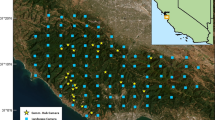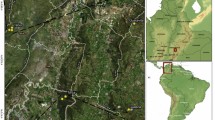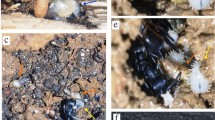Abstract
There are numerous reports of spiders that have become established outside of their native ranges, but few studies examine their impact on native spiders. We examined the effect of the European hammock spider Linyphia triangularis (Araneae, Linyphiidae) on the native bowl-and-doily spider Frontinella communis (Araneae, Linyphiidae) in Acadia National Park, Maine, USA. First, we added L. triangularis to established plots of F. communis. Significantly more F. communis abandoned their webs when L. triangularis were added compared to control plots. Second, we tested whether F. communis were deterred from building webs in areas where L. triangularis was established. Significantly fewer F. communis built webs on plots with L. triangularis than on control plots. In both experiments, L. triangularis sometimes took over webs of F. communis or incorporated F. communis webs into their own webs, but F. communis never took over or incorporated L. triangularis webs. Competition between L. triangularis and F. communis for both webs and web sites may contribute to the decline of F. communis.


Similar content being viewed by others
References
Almeida-Silva LM, Brescovit AD (2008) First record of Zimiris doriai (Araneae, Prodidomidae) in Brazil. J Arachnol 35:554–556
Amarasekare P (2002) Interference competition and species coexistence. Proc R Soc Lond B Biol Sci 269:2541–2550
Baird CR, Stolz RL (2002) Range expansion of the hobo spider, Tegenaria agrestis, in the northwestern United States (Araneae, Agelenidae). J Arachnol 30:201–204
Blakley NR, Dingle H (1978) Competition: butterflies eliminate milkweed bugs from a Caribbean island. Oecologia 37:133–136
Bradley RA, Cutler B, Hodge M (2006) The first records of Myrmarachne formicaria (Araneae, Salticidae) in the Americas. J Arachnol 34:483–484
Brawley SH, Cover JA, Blakeslee AMH, Hoarau G, Johnson LE, Byers JE, Stam WT, Olsen JL (2009) Historical invasions of the intertidal zone of Atlantic North America associated with distinctive patterns of trade and emigration. Proc Nat Acad Sci 106:8239–8244
Brescovit AD, Frietas GCC, Simão DV (2008) Spiders from the island of Fernando de Noronha, Brazil. Part III: Gnaphosidae (Araneae: Arachnida). Revista Brasileira de Zoologica 25:328–332
Eichenberger B, Siegenthaler E, Schmidt-Entling MH (2009) Body size determines the outcome of competition for webs among alien and native sheetweb spiders (Araneae: Linyphiidae). Ecol Entomol 34:363–368
Gaskett AC (2007) Spider sex pheromones: emission, reception, structures, and functions. Biol Rev 82:27–48
Gertsch WF, Peck SB (1992) The pholcid spiders of the Galapagos Islands, Ecuador (Araneae, Pholcidae). Can J Zool 6:1185–1199
Griswold CE, Ubick D (2001) Zoropsidae: a spider family newly introduced to the USA (Araneae, Entelegynae, Lycosidae). J Arachnol 29:111–113
Gruner DS (2005) Biotic resistance to an invasive spider conferred by generalist insectivorous birds on Hawai’i Island. Biol Invasions 7:541–546
Hann SW (1990) Evidence for the displacement of an endemic New Zealand spider, Latrodectus katipo Powell by the South African species Steatoda capensis Hann (Araneae: Theridiidae). N Z J Zool 17:295–307
Harwood JD, Obrycki JJ (2005) Web-construction behavior of linyphiid spiders (Araneae, Linyphiidae): competition and co-existence within a generalist predator guild. J Insect Behav 18:593–607
Herberstein ME, Craig CL, Elgar MA (2000) Foraging strategies and feeding regimes: web and decoration investment in Argiope keyserlingi Karsch (Araneae: Araneidae). Evol Ecol Res 2:69–80
Hill AM, Sinars DM, Lodge DM (1993) Invasion of an occupied niche by the crayfish Orconectes rusticus: potential importance of growth and mortality. Oecologia 94:303–306
Hoffmaster DK (1986) Aggression in tropical orb-weaving spiders a quest for food. Ethology 72:265–276
Holmes TP, Aukema JE, Von Holle B, Liebhold A, Sills E (2009) Economic impacts of invasive species in forests: past, present, and future. Ann NY Acad Sci 1162:18–38
Hougeneitzman D, Karban R (1995) Mechanisms of interspecific competition that result in successful control of Pacific mites following inoculations of Willamette mites on grapevines. Oecologia 103:157–161
Houser J (2007) The invasion of Linyphia triangularis (Araneae: Linyphiidae) in Maine: ecological and behavioral interactions with native species. Ph.D. dissertation, University of Massachusetts, Amherst
Huber BA (2001) The pholcids of Australia (Araneae; Pholcidae): taxonomy, biogeography, and relationships. Bull Amer Mus Nat Hist 260:3–144
Hutchinson R, Limoges RM (1998) Premiére mention de Synageles venator (Lucas) (Araneae: Salticidae) por l’Amériqie du Nord. Fabreries 23:10–16
Jakob EM (1991) Costs and benefits of group living for pholcid spiderlings: losing food, saving silk. Anim Behav 41:711–722
Jakob EM (2004) Individual decisions and group dynamics: why pholcid spiders join and leave groups. Anim Behav 68:9–20
Jakob EM, Porter AH, Uetz GW (2001) Site fidelity and the costs of movement among territories: an example from colonial web-building spiders. Can J Zool 79:2094–2100
Jennings DT, Catley KM, Graham F (2002) Linyphia triangularis, a Palearctic spider (Araneae, Linyphiidae) new to North America. J Arachnol 30:455–460
Kobelt M, Nentwig W (2008) Alien spider introductions to Europe supported by global trade. Diversity Distrib 14:273–280
Kuntner M (2005) A revision of Herennia (Araneae: Nephilidae: Nephilinae), the Australasian ‘coin spiders’. Invert Syst 5:391–436
Kuntner M (2006) A monograph of Nephilengys, the pantropical ‘hermit spiders’ (Araneae, Nephilidae, Nephilinae). Syst Ent 32:95–135
Martinez MJ (1993) Introduction of a new orb-weaving spider, Neoscona crucifera (Lucas) (Araneae, Araneidae), into California. Pan-Pac Entomol 69:274–275
Nihei N, Yoshida M, Kaneta H, Shimamura R, Kobayashi M (2004) Analysis on the dispersal pattern of newly introduced Latrodectus hasseltii (Araneae: Theridiidae) in Japan by spider diagram. J Med Entomol 41:269–276
Nyffeler M, Dondale CD, Redner JH (1986) Evidence for displacement of a North American spider, Steatoda borealis (Hentz), by the European species S. bipunctata (Linnaeus) (Araneae: Theridiidae). Can J Zool 64:867–874
Paquin P, Dupérré N (2003) Guide d’identification des Araignées (Araneae) du Québec. Fabreries Supplément 11, p 251
Pasquet A, Leborgne R, Lubin Y (1999) Previous foraging success influences web building in the spider Stegodyphus lineatus (Eresidae). Behav Ecol 10:115–121
Perkins TA, Riechert SE, Jones TC (2007) Interactions between the social spider Anelosimus studiosus (Araneae, Theridiidae) and foreign spiders that frequent its nests. J Arachnol 35:143–152
Persons MH, Walker SE, Rypstra AL (2002) Fitness costs and benefits of antipredator behavior mediated by chemotactile cues in the wolf spider Pardosa milvina (Araneae: Lycosidae). Behav Ecol 13:386–392
Reitz SR, Trumble JT (2002) Competitive displacement among insects and arachnids. Annu Rev Entomol 47:435–465
Riechert SE (1979) Games spiders play. Behav Ecol Sociobiol 6:121–128
Schneider SS, Deeby T, Gilley DC, DeGrandi-Hoffman G (2004) Seasonal nest usurpation of European colonies by African swarms in Arizona, USA. Insectes Soc 51:359–364
Schonewolf KW, Bell R, Rypstra AL, Persons MH (2006) Field evidence of an airborne enemy-avoidance kairomone in wolf spiders. J Chem Ecol 32:1565–1576
Snyder WE, Evans EW (2006) Ecological effects of invasive arthropod generalist predators. Annu Rev Ecol Syst 37:95–122
Tatem AJ (2009) The worldwide airline network and the dispersal of exotic species: 2007–2010. Ecography 32:94–102
Toft S (1987) Microhabitat identity of two species of sheet-web spiders: field experimental demonstration. Oecologia 72:216–220
Toft S (1988) Interference by web take-over in sheet-web spiders. XI European Arachnological Colloquium. Technical University, Berlin
Toft S (1990) Interactions among two coexisting Linyphia spiders. Acta Zool Fenn 190:367–372
Uetz GW (1992) Foraging strategies of spiders. Trends Ecol Evol 7:155–158
Venner S, Bel-Venner MC, Pasquet A, Leborgne R (2003) Body-mass-dependent cost of web-building behavior in an orb weaving spider, Zygiella x-notata. Naturwissenschaften 90:269–272
Venner S, Chades I, Bel-Venner MC, Pasquet A, Charpillet F, Leborgne R (2006) Dynamic optimization over infinite-time horizon: web-building strategy in an orb-weaving spider as a case study. J Theor Biol 241:725–733
Vetter R (1994) A nonnative spider, Metaltella simoni, found in California (Araneae, Amaurobiidae). J Arachnol 22:256
Vink CJ, Teulon DAJ, McLachlan ARG, Stufkens MAW (2004) Spiders (Araneae) and harvestmen (Opiliones) in arable crops and grasses in Canterbury, New Zealand. N Z J Zool 31:149–159
Wise DH (1993) Spiders in ecological webs. Cambridge University Press, Cambridge
Acknowledgments
Adam Porter, Ethan Clotfelter, Jeremy Houser, Skye Long, Sarah Partan, Ted Stankowich, Mary Ratnaswamy and two anonymous reviewers provided helpful comments on the manuscript. We are deeply grateful to Daniel Jennings for his assistance with this project. We thank the Acadia National Park rangers, especially David Manski, Bruce Connery, Ed Pontbriand, and Bill Widener for assistance throughout this project and for permission to work at the Park. Michelle Bierman, Jim McKenna, and staff of the Schoodic Education and Research Center provided crucial logistical support. This research was made possible by a grant from the National Park Service and US Geological Survey awarded to E. M. Jakob, J. Houser and D. Jennings.
Author information
Authors and Affiliations
Corresponding author
Rights and permissions
About this article
Cite this article
Bednarski, J., Ginsberg, H. & Jakob, E.M. Competitive interactions between a native spider (Frontinella communis, Araneae: Linyphiidae) and an invasive spider (Linyphia triangularis, Araneae: Linyphiidae). Biol Invasions 12, 905–912 (2010). https://doi.org/10.1007/s10530-009-9511-7
Received:
Accepted:
Published:
Issue Date:
DOI: https://doi.org/10.1007/s10530-009-9511-7




